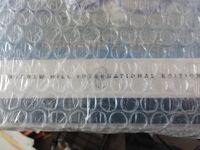
Water and Wastewater Engineering (Int'l Ed)
Water and Wastewater Engineering integrates theory and design. Fundamental environmental engineering principles are used as the foundation for rigorous design of conventional and advanced water and wastewater treatment processes. Reverse osmosis, membrane filtration, UV disinfection, biological nutrient removal and membrane bioreactors represent a small sample of the processes included. Water and Wastewater Engineering follows the flow of water through a water treatment plant and the flow of wastewater through a wastewater treatment plant. The design of unit water treatment processes includes coagulation/flocculation, softening, ion exchange, reverse osmosis, sedimentation, granular filtration, membrane filtration, disinfection, and residuals management. In a similar fashion, the design of unit wastewater processes follows the flow of wastewater through a plant. The design of unit wastewater treatment processes includes preliminary treatment, primary treatment, suspended growth secondary treatment including biological nutrient removal, and membrane biological reactors. Residuals management includes applicable methods to meet the 503 rules. The text includes include appropriate regulatory constraints and highlights safety issues. Hints from the field bring to the student real-life experience in solving technical issues.
Utgiven: 2010
ISBN: 9780071289245
Förlag: McGraw-Hill Education
Format: Häftad
Språk: Engelska
Sidor: 1024 st
Water and Wastewater Engineering integrates theory and design. Fundamental environmental engineering principles are used as the foundation for rigorous design of conventional and advanced water and wastewater treatment processes. Reverse osmosis, membrane filtration, UV disinfection, biological nutrient removal and membrane bioreactors represent a small sample of the processes included. Water and Wastewater Engineering follows the flow of water through a water treatment plant and the flow of wastewater through a wastewater treatment plant. The design of unit water treatment processes includes coagulation/flocculation, softening, ion exchange, reverse osmosis, sedimentation, granular filtration, membrane filtration, disinfection, and residuals management. In a similar fashion, the design of unit wastewater processes follows the flow of wastewater through a plant. The design of unit wastewater treatment processes includes preliminary treatment, primary treatment, suspended growth secondary treatment including biological nutrient removal, and membrane biological reactors. Residuals management includes applicable methods to meet the 503 rules. The text includes include appropriate regulatory constraints and highlights safety issues. Hints from the field bring to the student real-life experience in solving technical issues.
Begagnad bok (0 st)
Varje vecka tillkommer tusentals nya säljare. Bevaka boken så får du meddelande när den finns tillgänglig igen.



